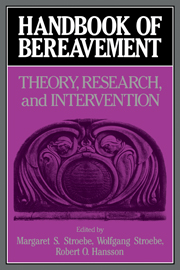Book contents
- Frontmatter
- Contents
- Contributors
- Preface
- Part I Introduction
- Part II The phenomenology and measurement of grief
- Part III Current theories of grief, mourning, and bereavement
- 5 Grief as an emotion and as a disease: A social-constructionist perspective
- 6 Bereavement as a psychosocial transition: Processes of adaptation to change
- 7 Grief: The social context of private feelings
- 8 Bereavement from the perspective of cognitive-experiential self-theory
- Part IV Physiological changes following bereavement
- Part V The psychological, social, and health impacts of conjugal bereavement
- Part VI Grief reactions to different types of loss
- Part VII Coping, counseling, and therapy
- Part VIII Conclusions
- References
- Author index
- Subject Index
6 - Bereavement as a psychosocial transition: Processes of adaptation to change
Published online by Cambridge University Press: 04 May 2010
- Frontmatter
- Contents
- Contributors
- Preface
- Part I Introduction
- Part II The phenomenology and measurement of grief
- Part III Current theories of grief, mourning, and bereavement
- 5 Grief as an emotion and as a disease: A social-constructionist perspective
- 6 Bereavement as a psychosocial transition: Processes of adaptation to change
- 7 Grief: The social context of private feelings
- 8 Bereavement from the perspective of cognitive-experiential self-theory
- Part IV Physiological changes following bereavement
- Part V The psychological, social, and health impacts of conjugal bereavement
- Part VI Grief reactions to different types of loss
- Part VII Coping, counseling, and therapy
- Part VIII Conclusions
- References
- Author index
- Subject Index
Summary
People are fascinating because of their individuality; no two problems are alike because no two people are alike. This tempts some people to reject theories of human behavior. There are none that can be expected to predict or explain more than part of a person, and it seems mechanistic to attempt to force people into preconceived models. Yet we must have some frame of reference if we are to be of use to those who cannot cope with life's vicissitudes. It is not enough for us to stay close and to open our hearts to another person's suffering; valuable though this sympathy may sometimes be, we must have some way of stepping aside from the maze of emotion and sensation if we are to make sense of it.
One might say that our central nervous system has been designed to enable us to do just that. Human beings, to a greater extent than other species, have the capacity to organize the most complex impressions into internal models of the world, which enable us to recognize and understand the world that we experience and to predict the outcome of our own and others' behavior. Psychological theories are one way of doing this, and the measure of their success is their usefulness.
This article describes a theory that the writer has found useful in explaining certain aspects of the human reaction to loss.
- Type
- Chapter
- Information
- Handbook of BereavementTheory, Research, and Intervention, pp. 91 - 101Publisher: Cambridge University PressPrint publication year: 1993
- 72
- Cited by

